31 Best Kettlebell Exercises
Introduction
We could advise mixing in some kettlebell movements if your typical dumbbell routines are making you feel a little dull. Changing up your load can give your program a fresh lease on life and offer a plethora of new possibilities to fit into whatever scheduled habit you may have.
This is due to the fact that kettlebells are an incredibly adaptable piece of equipment. You can press, push, pull, lunge, squat, deadlift, and carry them, just like dumbbells. This makes them excellent tools for adding difficulty to your upper-body, lower-body, or full-body workouts.
However, that does not imply that they may be substituted.
Kettlebells are actually the best for some weighted exercises, particularly those that call for quick movements. Furthermore, they are simpler to move around due to their rounded bell-bottom design and attached handle.
Additionally, you will vary the way your muscles perform when you grasp them from above because your range of motion will also be a little different.
But if you’ve never used kettlebells before, it can be intimidating to decide which exercises to do. Thus, we’ve put up a list of some of the top kettlebell workouts that target every muscle in your body. Let’s take a moment to clarify the essential information regarding these bells that aid in muscle growth before delving into them.
How heavy should your kettlebell be?
- The weight of the kettlebell you use will vary depending on a number of factors, including your level of strength and familiarity with the equipment. (Initiators should likewise begin with bodyweight exercises until they are at ease doing the movements with appropriate form.)
- That being said, a 10- to 15-pound kettlebell is a decent place to start. If you are more experienced in weightlifting and comfortable using larger weights, you may begin with a kettlebell weighing 20 pounds or more.
- It’s also critical to remember that the workouts you perform with kettlebells determine the “appropriate” weight for them. For example, compared to a triceps extension, which works smaller muscles, a deadlift, which works greater muscles, may allow you to go heavier.
Is 20 minutes of kettlebell training sufficient?
You can get in a decent workout in 20 minutes or less, therefore length is not a need for your workouts to be effective. If you’re short on time, you may complete a lot of work by scheduling your workout in circuits, which involve switching between exercises with little to no rest in between.
What exercises can you do with kettlebells?
- The options are practically limitless: You can perform almost anything you can do with dumbbells with kettlebells; you may only need to practice some basic kettlebell exercises first, like choosing the correct ones, gripping them, and making sure your technique is correct.
- You can perform a tonne of workouts with your bells if you’re comfortable utilizing them, such as variants of squats, deadlifts, shoulder presses, rows, and presses. With just one or two kettlebells, you may work your entire body depending on the exercises you pick. And to assist you in getting going.
31 Best Kettlebell Exercises
Following the 30 best kettlebell exercises listed below to gain ideas for creating your own kettlebell workout
Kettlebell Thrusters
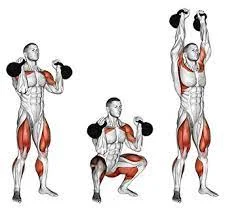
Steps To Follow:
- With the weight resting on the back of your shoulders, grasp two kettlebells by their handles.
- Maintaining your legs parallel to your shoulders, squat down with your knees slightly bent.
- Raise the kettlebells over your head by driving through and straightening your legs, then extending your arms.
- Return to a squat position.
Kettlebell Triceps Extension
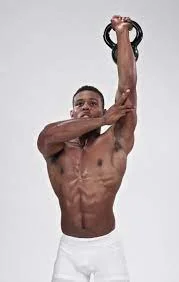
Your triceps, or the muscles at the rear of your upper arms, will be worked throughout this exercise. To ensure that your triceps are doing all the work, make sure your back is straight, not arched.
Here, it’s important to fully extend your arm at the top so that you can work your triceps through their entire range of motion. Because your triceps are small muscles, you might need to perform this exercise with a smaller weight in order to maintain proper form.
Steps To Follow:
- With the bell facing up, hold the kettlebell at chest height with both hands by the horns.
- Step forward with your left foot to create a posture that is staggered.
- You can choose to come up on your toes (as demonstrated above) or turn out your right toes to keep your rear foot flat on the floor.
- Press the weight above while keeping your hips tucked and your core active.
- Lower the kettlebell behind your head by bending at the elbows while keeping your arms aloft and your elbows firmly in place.
- Hold your elbows and biceps close to your head.
- To raise the weight and get back to your starting position, extend your arms straight.
- That amounts to one repeat.
Kettlebell Glute Bridge
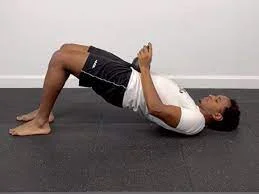
Your glutes, in particular your gluteus maximus, the largest muscle in your butt, will be worked throughout this workout. As you extend your hips, make sure you’re truly pressing into your heels.
Steps To Follow:
- With your feet flat on the floor, hip-width apart, and your knees bent, lie on your back.
- Kettlebells should be held by the handle and placed directly beneath your hip bones.
- This is where everything begins.
- Lift your hips a few inches off the ground by contracting your glutes and core and pushing through your heels until your body forms a straight line from your shoulders to your knees.
- At the peak, hold for a brief moment.
- Return the motion to its initial position.
- This is one repetition.
Kettlebell Clean and Press
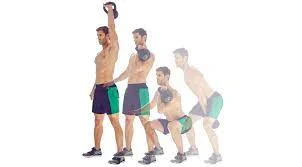
Steps To Follow:
- With your legs shoulder-width apart and your knees slightly bent, take a stance with two kettlebells by your thighs.
- Leap a little off the ground and raise your arms so they are above your head in one quick motion.
- Gently plant your feet, bending your knees slightly as if you were squatting, then raise your arms straight up above your head, shoulder-width apart.
- Then Repeat
Suitcase Carry
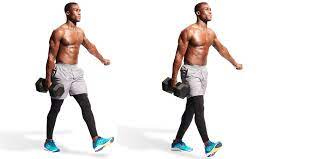
The suitcase carry is an excellent core workout because it requires you to maintain your balance by maintaining your weight on only one side. Your core muscles must work hard to keep you from bending to the side.
Steps to Follow:
- Set down a single kettlebell beside your foot.
- To secure the weight with a neutral, palms-in hold, squat down.
- Stand up with your core braced and your chest raised.
- Moving ahead, maintain an erect posture and fight the impulse to sag your body to compensate for the added weight.
- Consider that you are being drawn towards the ceiling by a string that is attached to the top of your head.
- Squat to return the weight to the floor after you’re done.
- On the other side, repeat.
Kettlebell Slingshot
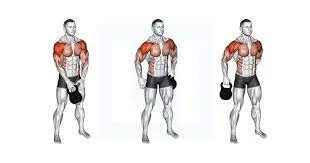
Utilized muscles
Obliques, Abdominals, Biceps, Triceps, Upper Trapezius, Deltoids, Subscapularis, Infraspinatus, Triceps, Forearms.
Steps To Follow:
- Select a hard but doable kettlebell weight.
- If you’re new to the workout, start out with less.
- Place your toes slightly outward and your feet shoulder-width apart as you stand.
- Maintain a straight back while tightening your core.
- With both hands, grasp the kettlebell in front of your thighs, towards the bottom of the handle.
- Swing the kettlebell between your legs and let it go behind your knees to start. Maintain a straight-arm posture and a focused core.
- Swing the kettlebell explosively up and around the outside of your right hip as it rises slightly behind you. To produce power, turn your shoulders and torso.
- Swing the kettlebell to your left hand at the top of the motion, passing it under your right arm and across your chest. Throughout the exercise, maintain the straightest possible arm posture.
- Swing the kettlebell around your left hip and transfer it under your left arm to your right hand, continuing the motion.
- Strive for a smooth, round movement that keeps your hips rotating and your core engaged.
Kettlebell Snatch
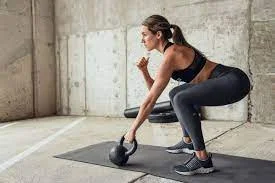
Steps To Follow:
- Step down till your thighs are parallel to the floor while squatting with a kettlebell in one hand held between your legs.
- As the kettlebell reaches shoulder height, drive forward through your hips and knees. Then, swivel your hand and push it upward until your arm is locked out.
- Lower yourself into a squat and put the weight back where it was. After doing so with one arm, switch sides.
Kettlebell Good Morning

Utilized muscles
Abdominals, Gastrocnemius, Erector Spinae, Gluteus Maximus, and Hamstrings.
Steps To Follow:
As though you were reclined in a chair, push your hips back and down. Remain upright with a straight back and refrain from hunching over.
Your hamstrings should feel stretched.
Lower yourself until you feel a noticeable stretch in your hamstrings or until your torso is almost parallel to the floor, whichever occurs first. Steer clear of compromising your lower back by going too low.
To raise yourself back up to the beginning position, contract your hamstrings and glutes.
Throughout the exercise, keep your spine neutral and your core active.
Kettlebell Pistol Squat
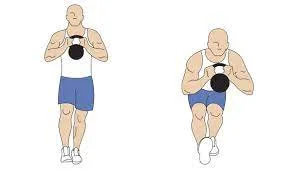
Steps To Follow:
- With both hands, hold one kettlebell slightly under your chin.
- Raise one leg off the ground and lower the other into a squat.
- Without letting your leg touch the floor, drive through your heel to return to a standing position.
- Return to the lower position and repeat.
Kettlebell Single Arm Deadlift

Utilized muscles
Adductor Magnus, Hamstrings, Gastrocnemius, Hip Adductors, Upper Trapezius, Abdominals, Quadratus Lumborum, Erector Spinae, Spinal Erectors, Gluteus Maximus (Medius & Minimus).
Steps To Follow:
- Choose a kettlebell that will test you but will still let you perform the reps with the proper form.
- If you’re not familiar with the exercise or have any lower back issues, start off more slowly.
- Maintain a neutral spine by standing with your feet hip-width apart and using your core.
- Continue to bend your knees slightly. Just out of your reach, place the kettlebell on the ground in front of you. With your back straight and your hand hinged at the hips, extend your reach downward.
- Firmly grasp the kettlebell handle in a neutral grip, with your palm facing your torso.
- Maintaining a straight back and lowered shoulders, slowly drive your hips back and down.
- Between your legs, let the kettlebell hang naturally.
- Feel your hamstrings flex as you hinge.
- To raise yourself back up to the starting posture, use your posterior chain and core.
- During the entire exercise, keep the kettlebell close to your body.
- To raise the kettlebell, utilize your hips and legs rather than your arm.
- Using the opposing hand to raise and lower the kettlebell, repeat the motion on the other side.
- For balance, go for equal reps on both sides.
Kettlebell Single Leg Deadlift
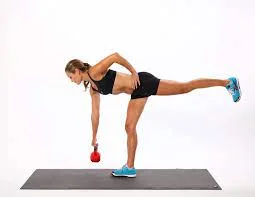
Steps To Follow:
- Spend five to ten minutes warming up your muscles with dynamic stretches and light aerobics before beginning any deadlifts.
- Choose a kettlebell that will test you but will still let you perform the reps with the proper form. If you’re not familiar with the movement or have any balance issues, start out slower.
- Maintain a neutral spine by standing with your feet hip-width apart and using your core. Continue to bend your knees slightly.
- Maintaining your foot flexed, shift your weight on one leg and extend the other leg straight behind you.
- At the same time, bend at the hips and use your free hand to reach down and grasp the kettlebell handle in a neutral hold (palm facing your body).
- Maintain a straight back and lowered shoulders.
- With your extended leg parallel to the floor and a long spine, slowly lower your torso and the kettlebell toward the ground.
- Your glutes and hamstrings should feel stretched.
- To raise yourself back up to the starting posture, use your posterior chain and core.
- Squeeze your glutes and drive into your standing leg to straighten your body.
- During the entire exercise, keep the kettlebell close to your body.
- After completing the required number of repetitions on one leg, swap legs and repeat the movement on the other side.
- For balance, go for equal reps on both sides.
Kettlebell Swing Two Hands
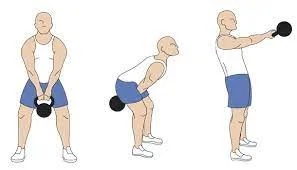
Utilized muscles
Legs: Hamstrings, Gluteus Maximus, Forearms, Erector Spinae, Quadriceps Femoris, Rhomboids, Trapezius, Deltoids, Latissimus Dorsi, Abs.
Steps To Follow:
- Maintain a straight back and lowered shoulders while pushing your hips back and down if you’re reclining in a chair.
- At the same time, ‘hike’ the kettlebell back a little bit between your legs, starting the movement with your glutes and hamstrings.
- Suddenly snap your hips forward as the kettlebell hits its lowest position. Squeeze your glutes and core to propel the kettlebell higher.
- Keep your back straight and stand tall with your hips extended. Rather than requiring you to pull with your arms, the kettlebell should automatically rise to chest height by momentum.
- As you get ready for the following repeat, let the kettlebell swing back between your legs with control, and hinge at your hips once more.
- Avoid hunching over or being pulled forward by the momentum.
- Continue to swing in a fluid, rhythmic manner, emphasizing driving the action with your hips and core.
- Breathe in as you swing back down and exhale as you drive upward.
Kettlebell Single-Handed Swing
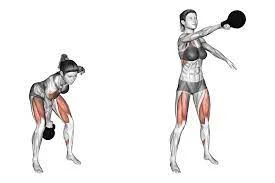
Steps To Follow:
- Maintain a straight back and lowered shoulders while pushing your hips back and down if you’re reclining in a chair.
- Using your hamstrings and glutes, simultaneously ‘lift’ the kettlebell back between your legs a little bit while keeping your arm engaged.
- Suddenly snap your hips forward as the kettlebell hits its lowest position. Squeeze your glutes and core to propel the kettlebell higher.
- Keep your back straight and stand tall with your hips extended. Pay attention to producing force with your hips and core rather than your arms.
- The kettlebell should gain momentum and naturally reach chest height.
- As you get ready for the following repeat, let the kettlebell swing back between your legs with control, and hinge at your hips once more.
- Avoid hunching over or being pulled forward by the momentum.
- Once you’ve done as many repetitions as you’d like on one side, carefully transfer the kettlebell to your other hand and continue the exercise there.
- For balance, go for equal reps on both sides.
Kettlebell Goblet Squat
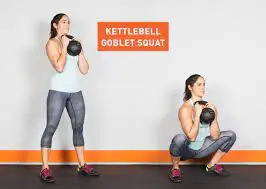
One of the greatest exercises for your butt, quadriceps, and hamstrings is the kettlebell goblet squat. Including a kettlebell increases the amount of resistance your body must overcome in order to get back up, further taxing your muscles.
Additionally, you can achieve perfect form and push your butt back for a deeper squat by holding the kettlebell close to your chest.
Steps To follow:
- Hold a kettlebell in both hands at your chest while standing with your feet slightly wider than hip-width apart and your toes slightly turned out.
- If holding it by the handles is more comfortable for you, you can also carry it by the bell.
- As you move your weight into your heels, push your hips back, bend your knees to lower into a squat, contract your core, and maintain an elevated chest and flat back.
- Squeeze your glutes once at the peak after driving through your heels.
Kettlebell Romanian Deadlift
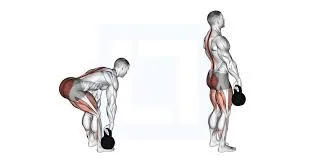
One of the best kettlebell exercises for the lower body is the kettlebell deadlift. Deadlifts are a great way to work your hamstrings and the backs of your legs. Since you have to maintain your abs firm to prevent arching your back, they also subtly test your core.
According to Sims, you should probably go for a higher weight when performing a deadlift because this exercise primarily works your glutes, which are probably some of the strongest muscles in your body.
Steps To follow:
- Place your feet hip-width apart and gently bend your knees. With both hands, hold a kettlebell in front of your thighs, palms in.
- For this workout, you can use two dumbbells in place of a kettlebell.
- As you lower your torso and the weight towards the floor, hinge your hips and push your butt back.
- Maintain a flat back and back shoulders.
- When you reach the bottom of the action, your torso should be nearly parallel to the ground.
- Push through your heels with a firm core to stand up straight and maintain a straight-arm posture.
Kettlebell Bent-Over Row
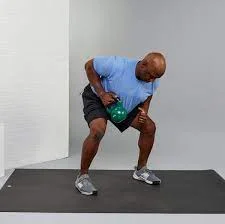
A traditional upper-body workout that targets your biceps, rhomboids, and lats is the row. To truly feel the workout in your arms and back and to prevent hurting your back Sims advises moving slowly and deliberately, “not like you’re starting a lawn mower.”Additionally, keep your head down to avoid straining your neck by looking at the floor instead of up.
Steps To Follow:
- Hold a kettlebell by its handle in each hand while keeping your arms by your sides. Stand with your feet hip-width apart.
- Make sure your back is parallel to the floor by pushing your butt back, bending your knees slightly, and hunching forward at the hips while maintaining an engaged core.
- (Depending on how flexible your hamstrings are, you might not be able to bend over as much.) Take a few inches to gaze down at the ground in front of your feet to ensure that your neck is in a comfortable posture.
- Squeeze your shoulder blades at the peak of the movement, clasp your elbows tight to your body, and pull the weights up towards your chest to perform a row. As you push the weights closer to your chest, your elbows should extend past your back.
- Here, pause, clenching your shoulder blades, and then slowly extend your arms towards the floor to reduce the weight. That amounts to one rep.
Kettlebell Overhead Press
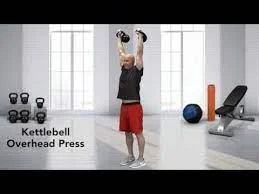
The kettlebell overhead press strengthens the muscles in your shoulders and triceps. Here, as you press the weight over your head, your core is also working to maintain the stability of your torso.
Steps To Follow:
- Place your feet hip-width apart as you stand.
- With your elbows bent and your palms facing inward, grasp a kettlebell by its handle in each hand at your shoulders.
- You should be carrying the bells on your shoulders.
- This is where everything begins.
- Completely extend your elbows and turn your hands so that the palms face out as you press the dumbbells overhead.
- When you raise your arms, make sure your hips are tucked in and your core strong to prevent arching your lower back.
- To return the weight to its original position, slowly bend your elbows.
- Return the movement to its initial position.
Kettlebell Split Squat
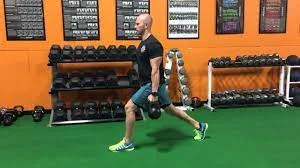
Similar to a goblet squat, the split squat targets your quads and glutes, but because you’re in a lunge posture, it’s regarded as a unilateral exercise as your front leg will be performing more of the work. However, because you aren’t truly moving forward, balancing won’t be as problematic as it would be in a typical lunge.
Steps To Follow:
- Grasp a kettlebell at your chest with both hands.
- (Alternatively, you might perform this exercise with a kettlebell dangling at your sides in each hand.)
- Step your left foot forward like you’re performing a forward lunge while keeping your left heel firmly planted with your feet beneath your shoulders.
- This is where everything begins.
- To make a 90-degree angle with your legs, bend both of your knees.
- To ensure that your back is flat and not rounded or arched forward, your torso should be somewhat front and your chest upright.
- Your left knee should be over your left foot and your left quad should be parallel to the floor.
- Your butt and core should be in use.
- Go back to where you were before by pushing through your left foot.
- After finishing all of your repetitions, swap sides.
Kettlebell Chest Press
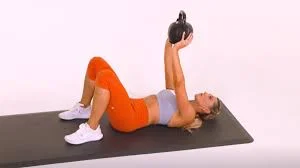
Any comprehensive fitness program must focus on strengthening your pectorals, or chest muscles, and pressing exercises are an excellent approach to achieve this. This exercise will target your triceps in addition to your pecs.
Steps To Follow:
- With your feet flat on the floor and your knees bent, lie face up.
- With your elbows bent less than 90 degrees on the floor and your hands neutrally positioned with your palms facing in, grasp a kettlebell by its handle in each hand.
- This is where everything begins.
- Keep your palms pointing inward and fully extend your elbows as you press the weights towards the ceiling.
- Here, pause for a moment.
- Bend your elbows slowly, then return them to the floor. This is one repetition.
Sit-Up to Press-Up
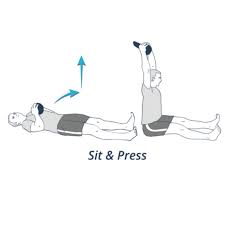
A sit-up with weight increases the strain on your core, and the press at the top tones your arms and shoulders as well. Depending on what feels good for your hips, Sims says you may do these sit-ups with your knees bent or in the butterfly position.
Steps To Follow:
- Hold a kettlebell with both hands at your chest while lying face up with your knees bent and your feet flat.
- This is where everything begins.
- Raise your body till your back is straight and you are sitting up straight using your abs.
- Press the weight overhead and extend both arms until your elbows are straight at the same moment.
- Return to the starting position slowly.
- This is one repetition.
Reverse Lunge
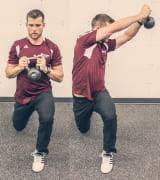
Due to their dynamic, unilateral nature, reverse lunges are an excellent workout for your quadriceps and glutes. They will also challenge your balance.
Steps To Follow:
- Maintain a shoulder-width distance between your feet while grasping a kettlebell in each hand by its handle at your chest.
- This is the initial position. (Alternatively, you can perform this exercise holding a kettlebell at either side.)
- Elevate your right foot and retreat approximately two feet, stepping onto the ball of your foot while maintaining your heel off the ground.
- Once your right shin and left quad are roughly parallel to the floor, bend both of your knees.
- To ensure that your back is flat and not rounded or arched, your body should bend slightly forward.
- Your left knee should be over your left foot, and your butt and core should be tense.
Kettlebell Swing
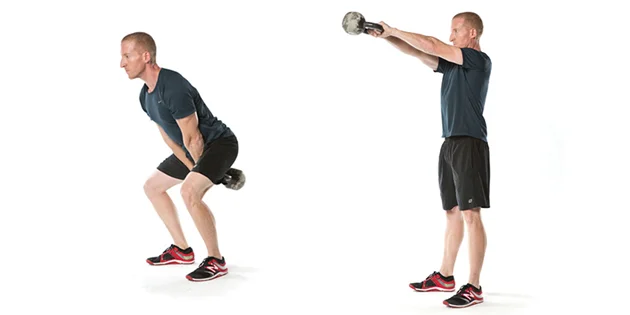
According to Sims, the kettlebell swing works your lower back, legs, and butt. Before adding too much weight, be sure you have mastered the technique with a lighter kettlebell. According to Sims, you must “thrust your hips aggressively to get the kettlebell up—don’t use your arms” in order to execute a swing correctly. Moreover, don’t forget to pinch your butt at the summit.
Steps To Follow:
- Holding the kettlebell with both hands and your arms extended straight in front of you, take a stance with your feet hip-width apart.
- To swing the kettlebell between your legs, flex your knees just a little bit and then pivot at the hips.
- Get to your feet, squeeze your glutes, and swing your arms forward to your chest (not higher than your shoulders) while propelling your hips forward explosively.
- Don’t let gravity do all the work for you as the weight descends.
- Reposition the weight, hunch down at the hips and begin the next rep right away.
Kettlebell Sumo Squat
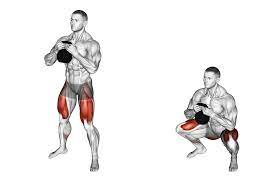
Similar to the goblet squat, this kettlebell squat variation works your inner thighs and glutes even more due to the wide sumo stance.
Steps To Follow:
- With your toes pointed outward, place your feet wider apart than shoulder-width apart.
- Both hands should be at your chest while you hold a kettlebell by its handle.
- This is where everything begins.
- As you move your weight into your heels, push your hips back, bend your knees to lower into a squat, contract your core, and maintain an elevated chest and flat back.
- Maintain a long spine and an open chest.
- Squeeze your glutes once at the peak after driving through your heels.
Kettlebell Single-Arm Row
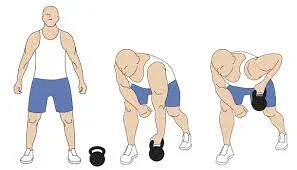
The single-arm kettlebell row strengthens your biceps and back muscles. It’s a unilateral maneuver, thus in order to stay stable, your core will also need to fire.
Steps To Follow:
- Holding a kettlebell by its handle with your right hand while keeping your arm at your side and your palm facing your body, take a stance with your feet hip-width apart.
- Place your left foot two feet ahead and place your left hand on your left quadriceps.
- This is where everything begins.
- Make sure not to round your shoulders as you push your butt back, bend your left knee, and hinge forward at the hips with your core engaged.
- Your ability to bend over will depend on how flexible your hamstrings and hips are.
- Maintain a comfortable position for your neck by looking down at the ground a few inches in front of your feet.
- Maintaining your elbows close to your body, pull the weight up towards your chest while squeezing your shoulder blade at the peak of the movement.
- As you pull the weight up to your chest, your elbow should cross your back.
- Reaching for the floor with your arms gradually reduces the weight.
- That amounts to one rep.
Kettlebell Farmer’s Walk
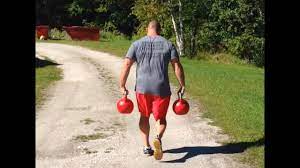
Steps To Follow:
- Keep two kettlebells close at hand.
- Walk as quickly and with strength in your arms as you can.
- Walk back after turning around.
Alternate Kettlebell Shoulder Press
Steps To Follow:
- Place your feet shoulder-width apart and grasp two kettlebells at shoulder height.
- When your arm reaches its maximum length, press one of the weights above your head.
- Lower, then switch to the other arm.
Turkish Get-Up
Steps To Follow:
- With a kettlebell held just above your right shoulder, lie down.
- Raise the kettlebell straight above your head with your right arm, then extend your left arm to the side.
- With your foot on the floor, bend your right knee and move it across your body.
- As you raise the kettlebell to a standing posture, continue to observe it, keeping it at arm’s length above you.
- Return the kettlebell to your shoulder after carefully reversing the motion to lie down.
Kettlebell Burpee Over
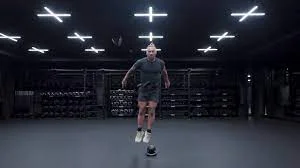
Steps To Follow:
- Hit the deck and drop your body until your chest meets the floor while holding a kettlebell on the ground next to you.
- Get back up and make a forceful leap over the bell.
- Repeat with a drop into another burpee.
Kettlebell Halo

This exercise tones your abdomen, chest, and shoulders. The secret is to rotate your arms and the weight while maintaining a rigid core and a solid torso. To prevent your back from arching, consider tucking your pelvis down, advises Sims. This makes sure your lower back isn’t strained when you’re working your abs.
Steps To Follow:
- With one foot and one knee on the ground and both knees bent 90 degrees, begin in a half-kneeling position.
- Alternately, place your feet hip-width apart. Grasp the handle of a kettlebell with both hands and hold it high at your chest. This is where everything begins.
- Raise the weight to eye level and slowly create a halo formation around your head by rotating it anticlockwise.
- To activate your triceps, keep your elbows close to your body while you rotate the weight around your head.
- You should also maintain a tight core.
- To get back to where you were before, reverse the motion.
- Next, carry out the reverse direction. This is one repetition.
- Proceed, switching directions each time.
Row of Chainsaws
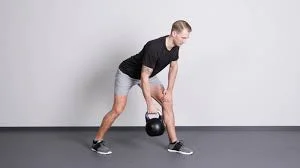
Steps To Follow:
- With the kettlebell on the ground and your body in a split stance, vigorously row the bell, leading with your elbow
- And maintaining your torso low.
- Return the kettlebell to the floor and wait one second before attempting the next repetition.
Swing in America
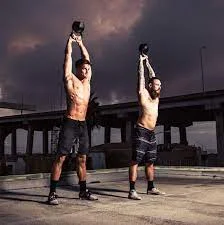
Steps To Follow:
- As you swing the kettlebell backward, flex at the hips. Place the kettlebell between your legs.
- To shoot it straight above your head, propel your hips forward.
- Allow yourself to be propelled back into the hinge position,
- then proceed directly to the second rep.
What are the benefits of kettlebell exercises?
As previously said, there are advantages to the design of a kettlebell that you won’t find with other types of resistance. Compared to a standard dumbbell, the weight distribution is varied, working different muscles for the same exercise.
Your wrists and forearms will also be slightly more taxed as a result of the increased wrist mobility required. Similar to dumbbells, kettlebells may be used to gradually test your muscles by raising the weight or the number of repetitions, which makes them an efficient tool for strength building.
Kettlebells are an excellent tool for low-impact training on power and explosiveness. Ultimately, the equipment’s efficiency and versatility rank among the kettlebell’s best advantages. There are plenty of kettlebell workouts that target every region of your body, so you don’t need a ton of them to get into a solid workout. Therefore, even if you have limited room in your home gym, kettlebells are a terrific alternative because you can get in a good, full-body exercise with only one bell.
How often should you use kettlebells?
Whether using kettlebells or any other type of equipment, you shouldn’t work out every day. Your muscles need time to recuperate so they can recover after a strength training session and grow back stronger. Days of rest are crucial because of this. Therefore, be careful to let at least 24 hours pass between exercises that focus on the same muscle groups.
For example, you should wait until at least Wednesday to engage your glutes, quadriceps, and hamstrings again if you’re working your lower body on Monday with kettlebell exercises like the kettlebell squat and deadlift.
Conclusion
Initially, kettlebells may test your patience. However, they can produce gains in muscular strength and cardiovascular fitness when done correctly.
With one kettlebell, you can engage multiple muscle groups at once. This makes it an excellent tool for total-body exercise. To perform a range of kettlebell workouts, you usually don’t need much space because kettlebells are compact enough to use any place.
The secret is to start cautiously and, if at all feasible, with a professional personal trainer’s assistance. You can progress to utilizing a higher weight and increase your reps and sets once you can do the exercises with proper form while using a lesser weight.
FAQs
Which kettlebell workout is the most effective?
The Swing
Probably one of the most well-known kettlebell workouts is the swing. Swings increase joint mobility, burn calories, build strength, and foster the development of explosive power. This is what makes it stand out as the best kettlebell workout.
Do workouts using kettlebells actually work?
Similar to dumbbells, kettlebells may be used to gradually test your muscles by raising the weight or the number of repetitions, which makes them an efficient tool for strength building.
How many kettlebell workouts are done each day?
Your fitness level and objectives—such as increasing your deadlift or vertical jump, explosive power, or endurance—will play a major role in this. Start by adding kettlebell swings to your regular exercise regimen and performing three to five sets of ten to twenty repetitions.
Is 20 minutes of kettlebell training sufficient?
You should space out your kettlebell training sessions throughout the week to obtain the maximum benefit. It would be considerably preferable to perform three 10-minute workouts, or even six 5-minute sessions, with a kettlebell rather than just one 20-minute workout. Shorter workouts allow you to maintain a higher intensity, which is advantageous.
References
- Davies, D., Hayes, A., & Neudecker, K. (2023, September 26). 25 of the Best Kettlebell Exercises to Build Muscle. Men’s Health. https://www.menshealth.com/uk/building-muscle/a758657/the-7-best-kettlebell-exercises-to-build-muscle/
- Brookes, G. (2023, August 11). 52 Kettlebell Exercises for Men and Women. Kettlebell Workouts by Greg Brookes. https://kettlebellsworkouts.com/kettlebell-exercises/
- CPT, A. M. W., & CPT, C. S. (2023, November 16). 15 Kettlebell Exercises That Will Work Every Muscle in Your Body. SELF. https://www.self.com/gallery/beginner-kettlebell-moves

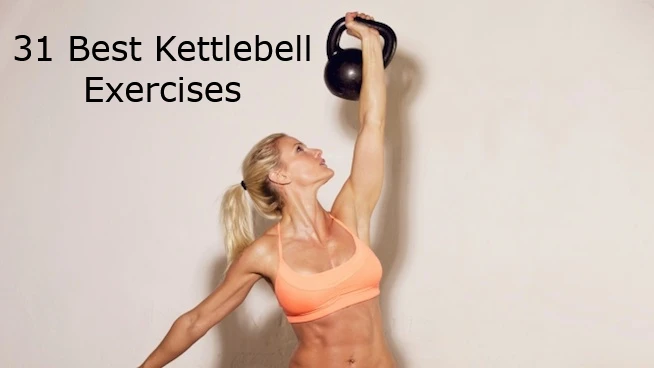
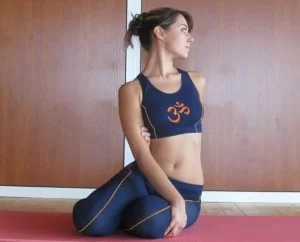
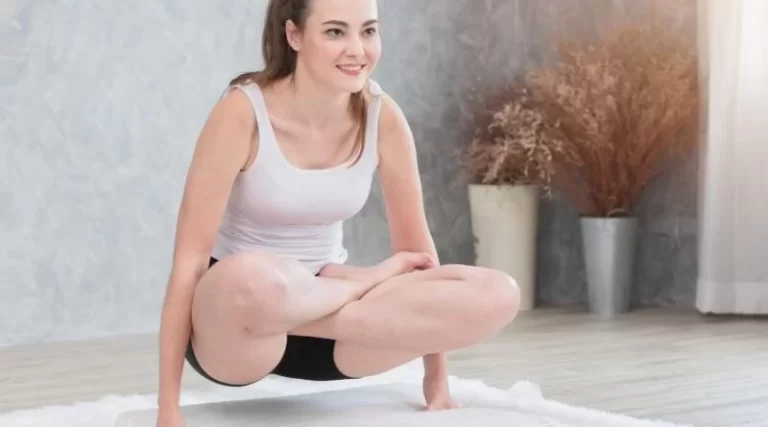
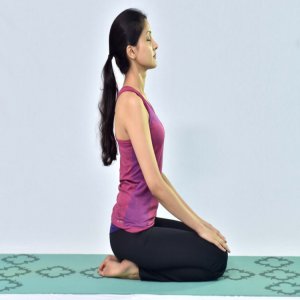

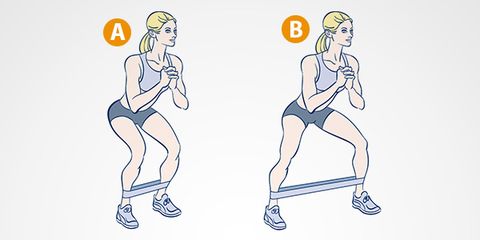
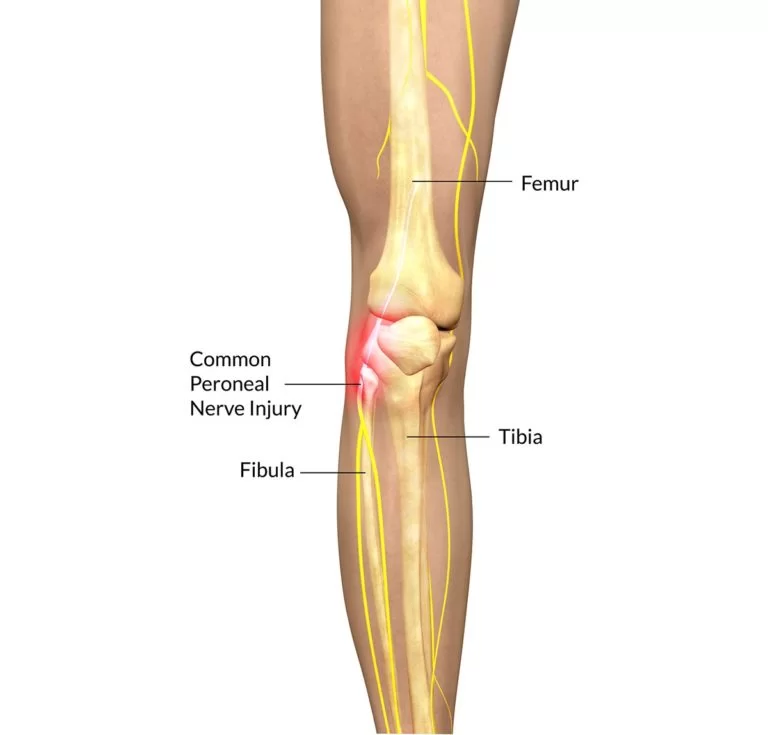
One Comment